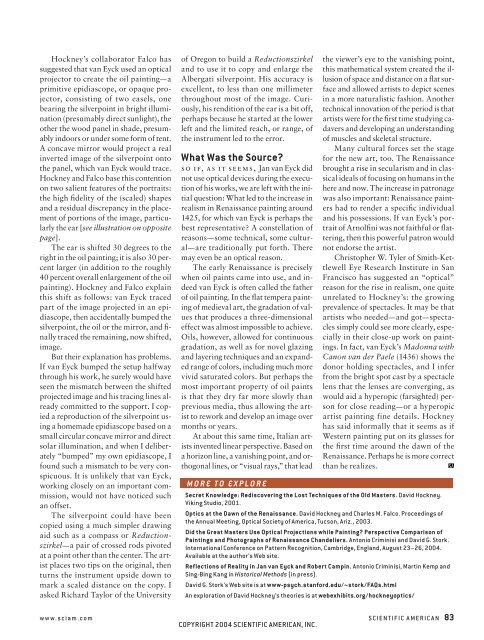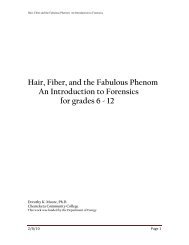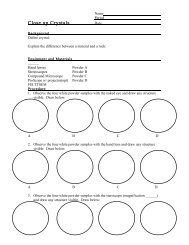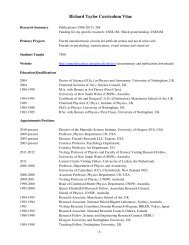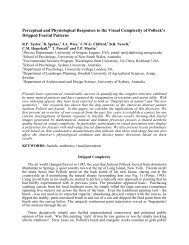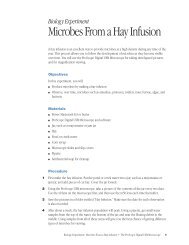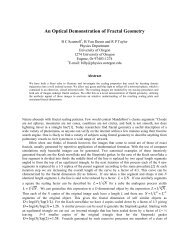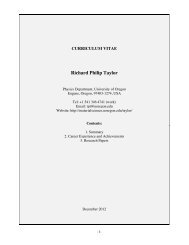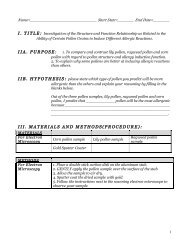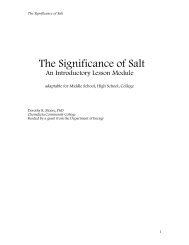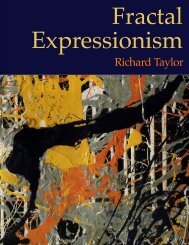December 2004 - Materials Science Institute - University of Oregon
December 2004 - Materials Science Institute - University of Oregon
December 2004 - Materials Science Institute - University of Oregon
You also want an ePaper? Increase the reach of your titles
YUMPU automatically turns print PDFs into web optimized ePapers that Google loves.
Hockney’s collaborator Falco has<br />
suggested that van Eyck used an optical<br />
projector to create the oil painting—a<br />
primitive epidiascope, or opaque projector,<br />
consisting <strong>of</strong> two easels, one<br />
bearing the silverpoint in bright illumination<br />
(presumably direct sunlight), the<br />
other the wood panel in shade, presumably<br />
indoors or under some form <strong>of</strong> tent.<br />
A concave mirror would project a real<br />
inverted image <strong>of</strong> the silverpoint onto<br />
the panel, which van Eyck would trace.<br />
Hockney and Falco base this contention<br />
on two salient features <strong>of</strong> the portraits:<br />
the high fi delity <strong>of</strong> the (scaled) shapes<br />
and a residual discrepancy in the placement<br />
<strong>of</strong> portions <strong>of</strong> the image, particularly<br />
the ear [see illustration on opposite<br />
page].<br />
The ear is shifted 30 degrees to the<br />
right in the oil painting; it is also 30 percent<br />
larger (in addition to the roughly<br />
40 percent overall enlargement <strong>of</strong> the oil<br />
painting). Hockney and Falco explain<br />
this shift as follows: van Eyck traced<br />
part <strong>of</strong> the image projected in an epidiascope,<br />
then accidentally bumped the<br />
silverpoint, the oil or the mirror, and fi -<br />
nally traced the remaining, now shifted,<br />
image.<br />
But their explanation has problems.<br />
If van Eyck bumped the setup halfway<br />
through his work, he surely would have<br />
seen the mismatch between the shifted<br />
projected image and his tracing lines already<br />
committed to the support. I copied<br />
a reproduction <strong>of</strong> the silverpoint using<br />
a homemade epidiascope based on a<br />
small circular concave mirror and direct<br />
solar illumination, and when I deliberately<br />
“bumped” my own epidiascope, I<br />
found such a mismatch to be very conspicuous.<br />
It is unlikely that van Eyck,<br />
working closely on an important commission,<br />
would not have noticed such<br />
an <strong>of</strong>fset.<br />
The silverpoint could have been<br />
copied using a much simpler drawing<br />
aid such as a compass or Reductionszirkel—a<br />
pair <strong>of</strong> crossed rods pivoted<br />
at a point other than the center. The artist<br />
places two tips on the original, then<br />
turns the instrument upside down to<br />
mark a scaled distance on the copy. I<br />
asked Richard Taylor <strong>of</strong> the <strong>University</strong><br />
<strong>of</strong> <strong>Oregon</strong> to build a Reductionszirkel<br />
and to use it to copy and enlarge the<br />
Albergati silverpoint. His accuracy is<br />
excellent, to less than one millimeter<br />
throughout most <strong>of</strong> the image. Curiously,<br />
his rendition <strong>of</strong> the ear is a bit <strong>of</strong>f,<br />
perhaps because he started at the lower<br />
left and the limited reach, or range, <strong>of</strong><br />
the instrument led to the error.<br />
What Was the Source?<br />
so if, as it seems, Jan van Eyck did<br />
not use optical devices during the execution<br />
<strong>of</strong> his works, we are left with the initial<br />
question: What led to the increase in<br />
realism in Renaissance painting around<br />
1425, for which van Eyck is perhaps the<br />
best representative? A constellation <strong>of</strong><br />
reasons—some technical, some cultural—are<br />
traditionally put forth. There<br />
may even be an optical reason.<br />
The early Renaissance is precisely<br />
when oil paints came into use, and indeed<br />
van Eyck is <strong>of</strong>ten called the father<br />
<strong>of</strong> oil painting. In the fl at tempera painting<br />
<strong>of</strong> medieval art, the gradation <strong>of</strong> values<br />
that produces a three-dimensional<br />
effect was almost impossible to achieve.<br />
Oils, however, allowed for continuous<br />
gradation, as well as for novel glazing<br />
and layering techniques and an expanded<br />
range <strong>of</strong> colors, including much more<br />
vivid saturated colors. But perhaps the<br />
most important property <strong>of</strong> oil paints<br />
is that they dry far more slowly than<br />
previous media, thus allowing the artist<br />
to rework and develop an image over<br />
months or years.<br />
At about this same time, Italian artists<br />
invented linear perspective. Based on<br />
a horizon line, a vanishing point, and orthogonal<br />
lines, or “visual rays,” that lead<br />
MORE TO EXPLORE<br />
the viewer’s eye to the vanishing point,<br />
this mathematical system created the illusion<br />
<strong>of</strong> space and distance on a fl at surface<br />
and allowed artists to depict scenes<br />
in a more naturalistic fashion. Another<br />
technical innovation <strong>of</strong> the period is that<br />
artists were for the fi rst time studying cadavers<br />
and developing an understanding<br />
<strong>of</strong> muscles and skeletal structure.<br />
Many cultural forces set the stage<br />
for the new art, too. The Renaissance<br />
brought a rise in secularism and in classical<br />
ideals <strong>of</strong> focusing on humans in the<br />
here and now. The increase in patronage<br />
was also important: Renaissance painters<br />
had to render a specifi c individual<br />
and his possessions. If van Eyck’s portrait<br />
<strong>of</strong> Arnolfi ni was not faithful or fl attering,<br />
then this powerful patron would<br />
not endorse the artist.<br />
Christopher W. Tyler <strong>of</strong> Smith-Kettlewell<br />
Eye Research <strong>Institute</strong> in San<br />
Francisco has suggested an “optical”<br />
reason for the rise in realism, one quite<br />
unrelated to Hockney’s: the growing<br />
prevalence <strong>of</strong> spectacles. It may be that<br />
artists who needed—and got—spectacles<br />
simply could see more clearly, especially<br />
in their close-up work on paintings.<br />
In fact, van Eyck’s Madonna with<br />
Canon van der Paele (1436) shows the<br />
donor holding spectacles, and I infer<br />
from the bright spot cast by a spectacle<br />
lens that the lenses are converging, as<br />
would aid a hyperopic (farsighted) person<br />
for close reading—or a hyperopic<br />
artist painting fine details. Hockney<br />
has said informally that it seems as if<br />
Western painting put on its glasses for<br />
the fi rst time around the dawn <strong>of</strong> the<br />
Renaissance. Perhaps he is more correct<br />
than he realizes.<br />
Secret Knowledge: Rediscovering the Lost Techniques <strong>of</strong> the Old Masters. David Hockney.<br />
Viking Studio, 2001.<br />
Optics at the Dawn <strong>of</strong> the Renaissance. David Hockney and Charles M. Falco. Proceedings <strong>of</strong><br />
the Annual Meeting, Optical Society <strong>of</strong> America, Tucson, Ariz., 2003.<br />
Did the Great Masters Use Optical Projections while Painting? Perspective Comparison <strong>of</strong><br />
Paintings and Photographs <strong>of</strong> Renaissance Chandeliers. Antonio Criminisi and David G. Stork.<br />
International Conference on Pattern Recognition, Cambridge, England, August 23–26, <strong>2004</strong>.<br />
Available at the author’s Web site.<br />
Reflections <strong>of</strong> Reality in Jan van Eyck and Robert Campin. Antonio Criminisi, Martin Kemp and<br />
Sing-Bing Kang in Historical Methods (in press).<br />
David G. Stork’s Web site is at www-psych.stanford.edu/~stork/FAQs.html<br />
An exploration <strong>of</strong> David Hockney’s theories is at webexhibits.org/hockneyoptics/<br />
www.sciam.com SCIENTIFIC AMERICAN 83<br />
COPYRIGHT <strong>2004</strong> SCIENTIFIC AMERICAN, INC.


